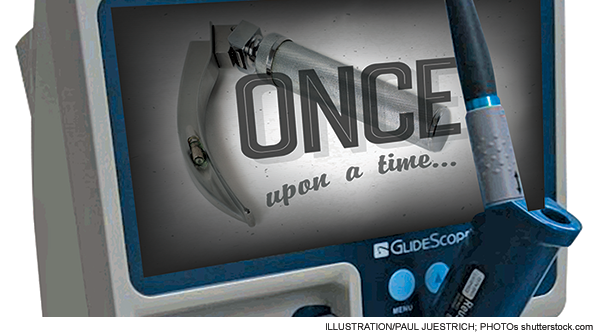
The treating physicians knew the treatment assignments, but this is not a concern because it is not possible to blind the clinicians given that VL and DL are different procedures that require different equipment.
Explore This Issue
ACEP Now: Vol 33 – No 08 – August 2014The strengths include that it was a randomized trial, all patients were followed up for the primary endpoint, and the study used video to record the resuscitation to avoid any bias inherent in a chart review.
The Bottom Line
VL leads to the same outcome as DL in trauma patients. VL takes longer to accomplish and may be associated with higher mortality in patients with severe head injuries. However, this relationship will require more study to confirm.
Case Resolution
You decide to use the GlideScope in this case because you feel that it might be better since the patient is in a cervical collar. Knowing that it may take a little longer to pass the tube, you make sure to properly pre-oxygenate the patient with high-flow oxygen with a non-rebreather mask at 30 to 60 liters per minute and use a nasal cannula set at 15 liters per minute kept on during your intubation attempt. You get an excellent view with the GlideScope and pass the tube on your first attempt.
Thank you to Dr. Steve Carroll from EM Basic for his help on this review.
Remember to be skeptical of anything you learn, even if you learned it from the Skeptics Guide to Emergency Medicine.
References
- Levitan RM, Heitz JW, Sweeney M, Cooper RM. The complexities of tracheal intubation with direct laryngoscopy and alternative intubation devices. Ann Emerg Med. 2011;57:240-247.
- Weingart SD1, Levitan RM. Preoxygenation and prevention of desaturation during emergency airway management. Ann Emerg Med. 2012;59:165-175.e1.
 Dr. Milne is chief of emergency medicine and chief of staff at South Huron Hospital, Ontario, Canada. He is on the Best Evidence in Emergency Medicine faculty and is creator of the knowledge translation project the Skeptics Guide to Emergency Medicine (www.TheSGEM.com).
Dr. Milne is chief of emergency medicine and chief of staff at South Huron Hospital, Ontario, Canada. He is on the Best Evidence in Emergency Medicine faculty and is creator of the knowledge translation project the Skeptics Guide to Emergency Medicine (www.TheSGEM.com).
Pages: 1 2 | Single Page






No Responses to “Is Video or Direct Laryngoscopy Better for Intubation in Trauma Patients?”